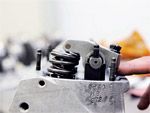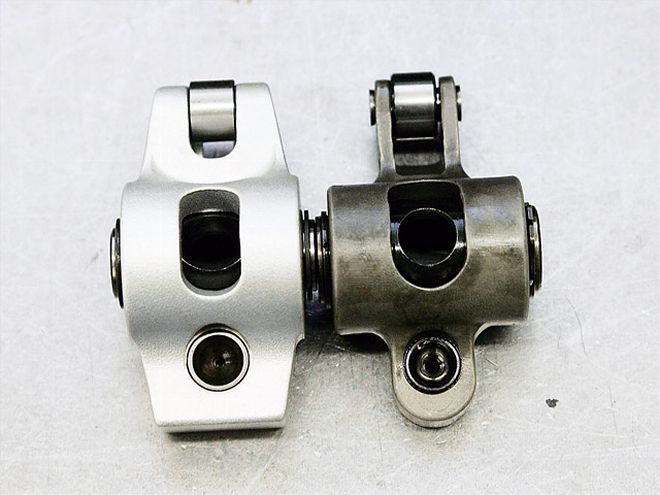
Somewhere along the line, as stock car racers, we've made a deal with the devil from which there is no turning back. Our lust for ever-increasing power levels is insatiable. To that end, inventive parts manufacturers and engine builders have been successful in squeezing power levels previously thought impossible from a carbureted pushrod V-8 small-block. Amazingly, as power has increased, so has durability.
But the price we have to pay for added power and durability is the need to have every part and piece within the engine meet very exacting tolerances. Too much or too little in either direction will lead to a costly failure. Take, for example, pushrods. In the "good old days," finding the perfect length for an engine wasn't as much a priority as it is now. That's because solid, non-roller rockers have a large flat that makes contact with the valve stem tip. Missing the pushrod length by a little bit wasn't much of a problem, because the flat on the rocker tip covered for the error. But today, almost every race car in every class can run roller-tip rocker arms. With the roller, the contact point between the rocker and the valve stem is very narrow. If you miss the mark, even by a little, you will get accelerated valveguide and valve stem wear. Also, big-lift camshafts and high-ratio rocker arms only exacerbate the problem. The point at which the rocker tip contacts the valve stem is controlled by the pushrod length, so getting that correct in today's racing engines is absolutely critical.
The problem is that when it comes to custom handbuilt engines, it is almost impossible to predict the correct pushrod length before the engine is actually assembled. Factors that can affect pushrod length include, but aren't limited to, the following: block deck height, cylinder head deck height, camshaft base circle, lifter design and height, valve stem length, and even the design of the rocker arms and corresponding mounting systems. Changing any of these variables can require significant length changes, so it is often difficult to predict exactly what you will need ahead of time. Instead, the easiest and most reliable plan is to wait until the engine is assembled to determine how long the pushrods need to be. Then, order the pushrods from your performance parts distributor and have them shipped overnight to your location.
So What? So what if I install the wrong length pushrods, you say? The engine still runs and the power seems to be OK. Yes, it might be in the beginning, but improperly sized pushrods-especially in an engine equipped with roller-tipped rockers-can be disastrous. When the valvetrain geometry is correct, the tip of the rocker makes contact with the top of the valve stem just north (the intake side) of the center of the valve tip, moves across the center of the valve tip at mid-lift and to the exhaust side of the tip at maximum lift, and then returns as the valve closes. The distance the roller tip travels on either side of the center of the top of the valve stem is equal. This maximizes the downward force the rocker places on the valve and minimizes side-loading on the stem.
When the pushrod length is not correct, the rocker arm tip won't be centered over the valve stem. When the camshaft activates the valvetrain, part of the force created by the motion of the rocker arm will push the valve stem laterally as well as vertically. When this happens, the valve stem scrubs against the valveguide in the head, causing excessive wear on both the valve stem and the guide. This wear will open up the valveguides and allow the valve to flop around. If you are lucky, the only problems will be poor valve control (engine power will drop sooner at the higher rpm levels), a loss of compression, and an engine that mysteriously starts burning oil. If it isn't caught, however, it can lead to a broken valve head and a junked engine.
Finding Center There are several ways to find proper pushrod length, but when it comes to stud-mounted rocker systems, the simplest way is to use a Sharpie and a wrench to turn the crankshaft. Even the most sophisticated engine builders use this method. Keith Dorton of Automotive Specialists says it is the most reliable and simplest way to determine correct pushrod length.
Begin by setting up the components for one cylinder. Because he builds hundreds of high-end engines a year in all different racing classes, Dorton keeps pushrods of multiple lengths and thicknesses on hand and simply test fits different ones until he finds exactly what he needs. Most of us, however, don't have that luxury. Instead, you can use an adjustable-length checking pushrod designed especially for this task.
Checking pushrods are sold by different manufacturers, but most operate on the same principle. They are typically two-piece units that are threaded to allow expansion in length. You can adjust the checking pushrod's length until you have what you need, then use that as a guide to order the real set. Some, such as Comp Cams' Hi-Tech checking pushrods, are threaded so that each revolution is equal to 0.050 inch of length. The pushrod's collapsed length is marked, so after you find the correct size, simply count the number of revolutions the pushrod has been expanded and you will know the right size to order the actual pushrods.
Whether you are using a checking pushrod or a standard piece that you think might fit correctly, begin by coloring the valve tip with either a Sharpie or machinist's dye. Then, install the pushrod and rocker arm while the lifter is on the base circle of the cam. If you are using a solid lifter, set the valvetrain to zero lash. If you are running a hydraulic lifter, tighten down the rocker adjuster to your normal preload. Using a wrench on the nose of the crank, turn the motor over several times, then remove the rocker and check the mark left on the valve tip. The roller tip on the rocker should have left a shiny spot where it wore away the ink you placed on the valve tip.
 All rocker designs are not the same-even if they are the same ratio. Both of these rockers have the same ratio. The steel unit (right) has contact points that are farther outboard from the pivot point. If you are having problems with the rocker contacting the spring retainer when the valve is closed, you may need to consider your rocker design. On our engine, the aluminum rocker on the left was allowing the pushrod to contact the guide plates; the steel rocker fixed that.
All rocker designs are not the same-even if they are the same ratio. Both of these rockers have the same ratio. The steel unit (right) has contact points that are farther outboard from the pivot point. If you are having problems with the rocker contacting the spring retainer when the valve is closed, you may need to consider your rocker design. On our engine, the aluminum rocker on the left was allowing the pushrod to contact the guide plates; the steel rocker fixed that.
If the pushrod length is correct, this mark should be centered across the top of the valve stem. If it is too high (closer to the lifter valley), try a slightly longer pushrod or lengthen the checker. If it is too low (closer to the exhaust ports), try a slightly shorter pushrod. Now simply repeat the process, adjusting the pushrod length each time, until you have the wear mark centered on the valve tip. Sometimes the low-tech methods really are the best.
If you are using a checking pushrod, you have two options. First, you can count the revolutions the pushrod has been expanded, calculate the extra length, and then add that to the pushrod's base length to find out what length of pushrods you should order. Or, you can simply wrap a piece of tape around the threads so the length won't change, package the checking pushrod, and send it off to your preferred pushrod manufacturer. The manufacturer matches your checker against its stock and ships the correct pushrods (along with your checker) back to you. Attempting to measure the pushrod with a set of calipers is problematic because the oiling holes on either end make it difficult to find the true tip of the pushrod because it has been cut away. Most manufacturers use a custom measurement tool that most of us don't have access to, so it's really better not to even try.
When you receive your new pushrods, it's not a bad idea to repeat the checking process with the new rods. This is the easiest way to ensure a mistake hasn't been made and that you haven't been sent the wrong length of pushrods. It's easy insurance.
What About Shaft-Mounted Systems?
Shaft-mounted rocker arm systems are becoming more common in racing and require a slightly different method for determining correct pushrod length. Instead of determining rocker arm height by sliding it up and down the rocker stud, a shaft-mounted system uses shims between the head and the base of the system. Many manufacturers, such as T&D and Jesel, offer a simple tool or gauge that helps you know when the rocker pivot height is correct. After you do that, you simply use a checking pushrod to determine the distance between the pushrod cup in the rocker to the pushrod seat in the lifter (while the lifter is sitting on the base circle of the cam).
Also, Dorton recommends keeping the adjuster nut in the pushrod side of the rocker screwed in so that most of it is up inside the body of the rocker. This is the strongest position, so when you determine the pushrod length, this is definitely where you want the adjuster.